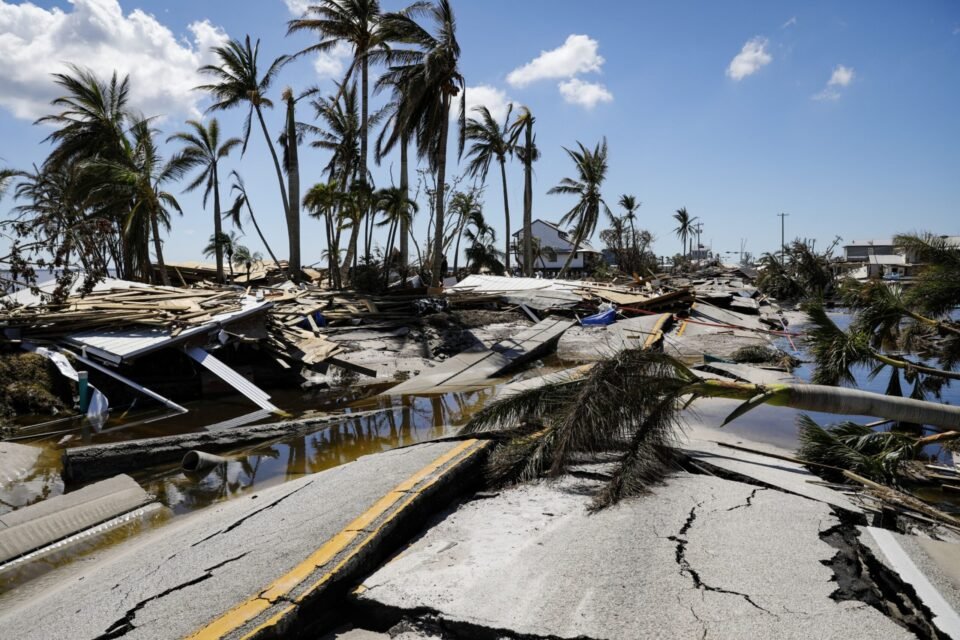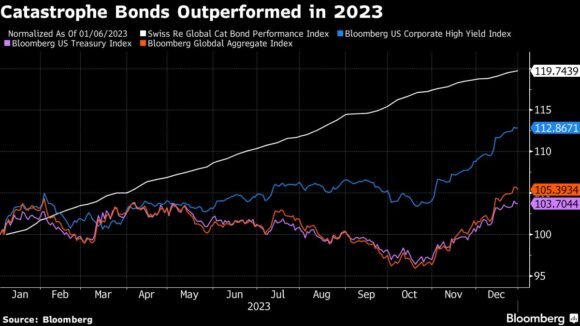For hedge funds, the science of catastrophes helped generate the best returns of any alternative investment strategy last year.
The calculus around natural disasters such as hurricanes and cyclones fed record gains at funds managed by firms including Tenax Capital, Tangency Capital and Fermat Capital Management. All three delivered results that were more than double an industry benchmark, according to public filings, external estimates and people familiar with the funds’ numbers.
Behind those record returns were bold bets on catastrophe bonds and other insurance-linked securities. So-called cat bonds are used by the insurance industry to shield itself from losses too big to cover. That risk is instead transferred to investors willing to accept the chance that they may lose a part of — or all — their capital if disaster hits. In exchange, they get rewarded with outsize profits if a contractually pre-defined catastrophe doesn’t occur.
Last year, everything came together for those investors in a uniquely profitable cocktail.
“I don’t think we’ve seen a market like this since cat bonds were born in the 1990s,” said Toby Pughe, an analyst at Tenax. The London-based hedge fund’s portfolio of about 120 of the securities delivered an 18% return last year.
The best hedge fund strategy of 2023 was a bet on insurance-linked securities (of which catastrophe bonds are the dominant sub-category), which generated over 14%, according to Preqin, a consultancy that provides data on the alternative asset management industry. Preqin’s benchmark return for the industry — across strategies — was 8%. That compares with a 19.7% gain in the Swiss Re Global Cat Bond Performance Index Total Return.
Cat bond issuance has been turbo-charged by concern about extreme weather events fueled by climate change, and by decades-high inflation that’s added to the cost of rebuilding after natural disasters.
But the seeds of 2023’s record cat-bond performance were planted several years ago.
The securities were generally a dud bet as recently as 2017, when several large hurricanes slammed into the US and investors were called on to cough up the cash needed to cover property losses. Returns were also underwhelming in 2019 and 2020.
Then, hurricane Ian hit Florida in September 2022.
Ian was the most destructive storm in the state’s history, causing $100 billion in losses of which only 60% was insured, according to Munich Re. The event led insurers to shift more of the risk on their books to the capital markets. And with much higher reconstruction costs amid rampant inflation, the stage was set for the market for cat bonds to come roaring back.
“The increase in insured values on the residential side went from 8% to 20%,” said Jean-Louis Monnier, global head of insurance-linked securities at Swiss Re. “Insurance companies needed to buy more cover.”
In 2023, cat bond issuance reached an all-time high of $16.4 billion, including non-property and private transactions, according to Artemis, which tracks the market for insurance-linked securities. Those deals brought the total outstanding market to a record $45 billion, it estimates.
To mop up the influx of newly-issued risk, cat bond investors demanded — and received — much bigger returns. Spreads — the premium over the risk-free rate that investors get paid to take on “catastrophe” risk — reached a high in early 2023. Returns were then amplified by a relatively benign US hurricane season, meaning fewer trigger events and more money for investors.
Greg Hagood, co-founder of Nephila Capital, a $7 billion hedge fund specializing in reinsurance risk, said that last year’s spreads “were probably the highest they’ve been in my career, relative to the risk we’re taking.”
Dominik Hagedorn, co-founder at Bermuda-based Tangency Capital, said hedge fund interest in insurance-linked securities has picked up “quite significantly” over the past 12 to 18 months. “Given where the spreads are at the moment, I wouldn’t be surprised if that stayed like that for another year or so,” he said.
The impact of global warming on weather patterns is a key feature of cat bond modeling, with recent changes setting the stage for new patterns of loss.
Karen Clark, a pioneer in modeling catastrophe risk, says there is increasing market interest in so-called secondary perils, such as severe convective storms, winter storms and wildfires, because that’s where the demand and opportunities are.
“Climate change is having the biggest impact on wildfires,” where individual events will lead to losses ranging from $10 billion to $30 billion, said Clark, co-founder of Boston-based Karen Clark & Co. “That’s where the cat bond market can grow.”
And earlier this month, Munich Re’s chief climate scientist, Ernst Rauch, said insurers are having to rethink how to classify storms.
“We used to refer to regional thunderstorms as secondary perils because they only cause small or medium-sized damage on their own,” according to Rauch. “But as the number of thunderstorms increases, we have to think about a new classification.”
Brett Houghton, a managing director at Fermat, which delivered about 20% last year on its roughly $10.8 billion of assets, said that such secondary perils are a good way to “help diversify your portfolio.” He also said they remain hard to model, which means they come with “some uncertainty.”
Cat bonds are also expanding to include new kinds of risk. Last year marked the first time investors in public markets were able to buy exposure to cyber-catastrophe bonds, which corporate executives now rate as one of their most feared external threats.
Cyber cat bonds “were a big success in 2023,” said Monnier of Swiss Re. “There’s still a limited subset of investors that can invest in cyber, but I think the next step will be a broadening of acceptance” from Wall Street.
Global cat bond capacity has grown at about 4% annually for the past six years — adjusted for inflation — which is roughly in line with the growth of natural catastrophe exposures, according to Swiss Re Institute. Globally, ILS capital reached about $100 billion at the end of the third quarter of 2023, insurance broker Aon Plc estimates.
Cat bond investors hoping for another record year should note that inflows have tightened spreads, according to Hagedorn at Tangency. And Tenax reckons its return on cat bonds this year may be around 10% to 12%, compared with last year’s 18%. That’s assuming 2024 is another “no loss year,” meaning there’s no natural disaster big enough to trigger the bonds’ carefully worded payment clauses.
“I can’t tell you if there’s going to be a hurricane or earthquake this year, obviously,” said Hagood of Nephila Capital. “But what I can tell you is spreads are near historical highs in the sector. So broadly speaking, we believe the market is being well paid for the risk.”
Photo: The destroyed Pine Island Road following Hurricane Ian in Matlacha Isles, Florida, in 2022. Photographer: Eva Marie Uzcategui/Bloomberg
Topics
Catastrophe
Profit Loss


